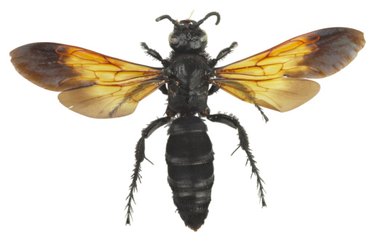
Wasps that are about 2 inches long are otherwise known as hornets, and they are particularly common in the northeast of the United States. Hornet wasps can cause painful stings if they are aggravated. They build nests in public places, and therefore it is important to identify them so you can steer clear. It is helpful to understand the characteristics of other common wasps -- such as yellowjackets -- so you can compare them against the hornet. By doing so, you confirm its identify more accurately.
Step 1
Measure the approximate size of the wasp. Use your thumb to do this because is an easy and convenient tool to use. First, measure the length of your thumb. Then, put your thumb out and hold it next to the body of the wasp. Compare the two to verify the wasp's size. A hornet is up to 2 inches in length, while potter, mud or pollen wasps are all less than an inch long.
Video of the Day
Step 2
Check the shape of the insect. A wasp like a hornet has an oval-shaped abdomen that tapers into a point, similar to the yellowjacket. However, the yellowjacket is much smaller and does not exceed more than 1/2 inch in length. The abdomen of the hornet is up to 1 1/2 inches in length. It is wider and longer than that of a yellowjacket.
Step 3
Verify the pattern and colors on the body of the insect. A hornet can be yellow, black or a combination of the two. For example, the bald-faced hornet found in Utah is black with white markings on its head. However, the most common form of hornet has distinctive black and yellow stripes.
Step 4
Watch the activities of the insect to observe its behavior. Hornets are less aggressive and active than smaller wasps. They kick their legs and subdue their prey but it is only when disturbed. Watch to check how fast it moves and reacts to movement; if it is a hornet, it will be slower than a yellowjacket.
Step 5
Assess the whole area around the insect. Hornets are a sociable species of wasp, so you may find similar hornets flying around. Identify the same species of wasp rather than mud wasps or cicadas which only have up to 50 insects in their nests, for instance.
Step 6
Find the wasp's nest by following the hornet's flightpath. Hornets build large egg-shaped nests in trees, buildings or crevices. The nest can be the size of a football and contain up to 700 other hornets, and often close to where it is looking for food. However, yellowjackets usually build their nests low down on or in the ground such as under an object.
Step 7
Compare the large wasp you have seen against pictures in an insect book to see which image it most closely relates to. Alternatively, use a resource such as the "Wasps, Yellowjackets and Hornets" information guide published by the University of Utah to identify the wasp. The "Wasp Identification Manual" by Adkins Bee Removal is also a suitable reference.
Warning
Do not attempt to catch, pick up or touch the wasp as it could cause a painful sting.
Video of the Day